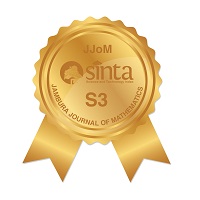Efektivitas Metode Hibrida ARIMA-MLP untuk Peramalan Nilai Tukar Petani
Abstract
Keywords
Full Text:
PDFReferences
BPS, "Pertumbuhan Ekonomi Indonesia Triwulan I-2023" in Berita Resmi Statistik, No. 34/05/.2023, pp. 1-13. [Online]. Available: https://www.bps.go.id/id/pressrelease/2023/05/05/1998/ekonomi-indonesiatriwulan-i-2023-tumbuh-5-03-persen-y-on-y-.html
BPS, "Profil Kemiskinan di Indonesia Maret 2023" in Berita Resmi Statistik, No. 47/07/.2023, pp. 1-14. [Online]. Available: https://www.bps.go.id/id/pressrelease/2023/07/17/2016/profil-kemiskinandi-indonesia-maret-2023.html
BPS, Statistik Nilai Tukar Petani 2022. Jakarta: Badan Pusat Statistik, 2023.
BPS, "Nilai Tukar Petani (NTP)" 2023. [Online]. Available: https://yogyakarta.bps.go.id/subject/22/nilai-tukar-petani
G. P. Zhang, Time series forecasting using a hybrid ARIMA and neural network model. USA: Neurocomputing, 2003. doi: 10.1016/S0925-2312(01)00702-0.
I. K. Hasan and I. Djakaria, "Perbandingan Model Hybrid ARIMA-NN dan Hybrid ARIMA-GARCH untuk Peramalan Data Nilai Tukar Petani di Provinsi Gorontalo" J. Stat. dan Apl., vol. 5, no. 2, pp. 155-165, 2021, doi: 10.21009/JSA.05204.
P. Young-Seuk and L. Sovan, "Artificial Neural Networks: Multilayer Perceptron for Ecological Modeling" in Ecological Model Types, Elsevier, vol. 28, pp. 123-140, 2016, doi: 10.1016/B978-0-444-63623-2.00007-4.
D. W. Yunita, "Peramalan Nilai Tukar Petani di Jawa Timur Menggunakan ARIMA BOX JENKINS" Institut Teknologi Sepuluh Nopember, 2018.
W. Istiqomah and M. Y. Darsyah, "Efektivitas Metode Arima dan Exponential Smoothing untuk Meramalkan Nilai Tukar Petani di Jawa Tengah" in Prosiding Seminar Nasional Mahasiswa Unimus, 2018, pp. 343-350.
T. W. Khusniyah and Sutikno, "Prediksi Nilai Tukar Petani Menggunakan Jaringan Syaraf Tiruan Backpropagation" Sci. J. Informatics, vol. 3, pp. 11-18, 2016, doi: 10.15294/sji.v3i1.4970.
E. Widada, "Prediksi Nilai Tukar Petani D.I.Yogyakarta Menggunakan JST dengan Algoritma Backpropagation" Universitas Teknologi Yogyakarta, 2018.
M. Khashei and Z. Hajirahimi, "Perfomance Evaluation of Series and Parallel Strategies for Financial Time Series Forecasting" Financ. Innov., vol. 3, pp. 1-24, 2017, doi: 10.1186/s40854-017-0074-9.
D. S. de O. S. Júnior, J. F. L. de Oliveira, and P. S. G. de M. Neto, "An Intelligent Hybridization of ARIMA with Machine Learning Models for Time Series Forecasting" Knowledge-Based Syst., vol. 175, pp. 72-86, 2019, doi: 10.1016/j.knosys.2019.03.011.
N. Tampati, Y. M. Pranoto, and Gunawan, "Prediksi Stok Obat Pada Total Life Clinic Menggunakan Model Kombinasi Artificial Neural Network dan ARIMA" J. Tek. Inform. dan Sist. Inf., vol. 9, pp. 49-58, 2022, doi: 10.35957/jatisi.v9i1.1373.
E. Setyowati and R. C. Utama, "Implementation of hybrid ARIMA-neural network model: Total assets of Indonesia Sharia banking data" in AIP Conference Proceedings, 2023. doi: 10.1063/5.0154635.
D. A. Anggraini, S. Wahyuningsih, and M. Siringoringo, "Peramalan Harga Minyak Mentah Indonesia Jenis Sepinggan Yakin Mix Menggunakan Model Hybrid ARIMA-NN" J. Ris. Pembang., vol. 5, pp. 105-118, 2023, doi: 10.36087/jrp.v5i2.138.
S. Maslikha, N. Fitriyati, and Mahmudi, "Aplikasi Model GSTAR-I dengan Pendekatan Invers Matriks Autokovarians (IMAk) pada Prakiraan Curah hujan di Provinsi Banten" J. LOGIK@, pp. 73-85, 2017.
J. E. Hanke and D. W. Wichern, Business Forecasting, Eight Edition. New Jersey: Pearson Prentice Hall, 2005.
W. W. S. Wei, Time Series Analysis: Univariate and Multivariate Methode, Second Edition. Pearson Prentice Hall, 2006.
A. de Myttenaere, B. Golden, L. B. Grand, and F. Rossi, "Using Mean Absolute Percentage Error for Regression Models" 23rd Eur. Symp. Artif. Neural Network, Comput. Intell. Mach. Learn., 2015, doi: 10.48550/arXiv.1506.04176.
J. J. M. Moreno, A. P. Pol, A. S. Abad, and B. C. Blasco, "Using the R-MAPE index as a resistant measure of forecast accuracy" Psicothema, vol. 25, pp. 500-506, 2013, doi: 10.7334/psicothema2013.23.
E. K. P. Chong and S. H. Zak, An Introduction to Optimization, Fourth Edition. John Wiley & Sons, Inc., Hoboken, New Jersey, 2013.
S. Sen, D. Sugiarto, and A. Rochman, "Prediksi Harga Beras Menggunakan Metode Multilayer Perceptron (MLP) dan Long Short Term Memory (LSTM)" Ultim. J. Tek. Inform., vol. 12, no. 1, pp. 35-41, 2020, doi: 10.31937/ti.v12i1.1572.
Y. Ardilla, "Metode Hibrida ARIMA Dan Multilayer Perceptron Untuk Peramalan Jangka Pendek Konsumsi Listrik Di Jawa Timur - Hybrid ARIMA And Multilayer Perceptron For Short Term Forecasting Of Electricity Consumption In East Java" Institut Teknologi Sepuluh Nopember, 2016. [Online]. Available: http://repository.its.ac.id/id/eprint/72011.
L. S. Dewi, "Prediksi Harga Saham Perusahaan Kelapa Sawit Menggunakan Pemodelan MLP Dan RBF" Techno Nusa Mandiri, vol. 11, no. 1, pp. 79-85, 2014.
P. Wibowo, S. Suryono, and V. Gunawan "Pengaruh Perbedaan Jumlah Hidden Layer dalam Jaringan Syarf Tiruan Terhadap Prediksi Kebutuhan Captopril dan Paracetamol pada Rumah Sakit" J. Media Aplikom, vol. 11, no. 2, pp. 45-58, 2019, doi: 10.33488/2.ma.2019.2.207.
DOI: https://doi.org/10.37905/jjom.v6i1.23944
Copyright (c) 2024 Saffanah Nur Elvina Mulyawati, Mujiati Dwi Kartikasari

This work is licensed under a Creative Commons Attribution-NonCommercial 4.0 International License.
Jambura Journal of Mathematics has been indexed by
Jambura Journal of Mathematics (e-ISSN: 2656-1344) by Department of Mathematics Universitas Negeri Gorontalo is licensed under a Creative Commons Attribution-NonCommercial 4.0 International License. Powered by Public Knowledge Project OJS.
Editorial Office
Department of Mathematics, Faculty of Mathematics and Natural Science, Universitas Negeri Gorontalo
Jl. Prof. Dr. Ing. B. J. Habibie, Moutong, Tilongkabila, Kabupaten Bone Bolango, Gorontalo, Indonesia
Email: [email protected].




















